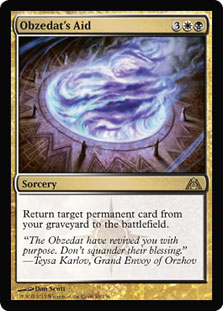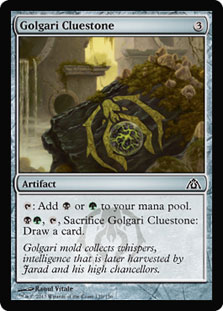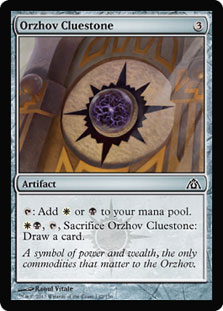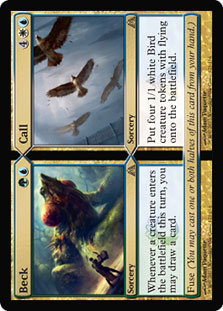The few weeks before a new set is released embody the essence of speculation and excitement that otherwise floats around the sidelines of the Magic community. These are the few weeks when it’s ok to take something about which we only have partial information (the spoiler) and make wild speculations, placing signposts pointing in a wide variety of directions—a few of which will yield meaningful paths and the rest of which point off of cliffs.
Fortunately, Dragon’s Maze gives us a lot to work with when it comes to speculation. There are a lot of card designs in this set that are fairly different from things we’ve seen before, and there are a lot of improvements on previously existing designs. This means that we not only can look to update existing archetypes with new “tech,” but we also can imagine entirely new prototypes.
In no particular order, let’s delve right into the maze!
Our story begins with a look at Obzedat’s Aid in Standard.
As a pure creature Reanimation spell it’s basically outclassed by Unburial Rites as long as we’re playing in our own yard. In many situations, Unburial Rites is actually the cheaper spell (assuming we have it in our graveyard), and if we’re forced to pay the full five mana, we have the ability to Reanimate two different creatures.
If we want Obzedat’s Aid to do anything interesting in Standard, it will need to target noncreature cards. The initial direction in which my mind traveled was planeswalkers, but the format isn’t structured in such a way right now that it’s immediately obvious how good it would be to have a spell that Reanimates planeswalkers (after all, aside from a few Garruks in decks here and there, this hasn’t been a particularly planeswalker-friendly format).
So what’s the biggest, baddest card we can Reanimate? In Standard, the award goes to Omniscience. There already are some relatively powerful—and definitely fun—Omniscience ramp decks in the format courtesy of a variety of deckbuilders. If we can develop a way to more consistently—or equally consistently but more powerfully—resolve and win games with Omniscience via Obzedat’s Aid, then we might be on to something.
Creatures (1)
Lands (22)
Spells (37)

This deck probably shouldn’t even be played in this state. This is simply an initial sketch of an idea. There are things that I really like about this list and things that are potentially crippling weaknesses.
I like the fact that some potential draws win the game on the fourth turn. Many opening hands with Obzedat’s Aid, lands, and spells that are not Omniscience are very strong. Simply hitting a Grisly Salvage into a Farseek or Cluestone puts us into a good position. However…
This deck needs to (a) have an Obzedat’s Aid or Increasing Ambition in hand to win and (b) needs to be able to mill a copy of Omniscience. If it does these two things, absent countermagic (of which there isn’t much in the current format outside of the stray Esper or RUG Flash deck), it will win the game. But if we fail to do both of these things, we lose. We also lose to decks with a fourth turn clock unless we’re on the play.
This shell is potentially faster than the current Omniscience decks but lacks the resiliency of, say, four Fog and four Snapcaster Mage. It also has a more situational path to victory because it isn’t just ramping up to Omniscience. Is the potentially more frequent fourth turn win worth the weakened defense structure and resiliency?
As of now, it looks like the “traditional” Omniscience decks are stronger, but if we continue to explore in this direction, we might find a way to improve the archetype. One such technique might be the inclusion of red for cards like Faithless Looting and Shattered Perception (over Mulch and Grisly Salvage) because these cards enable us to more effectively obtain a copy of Obzedat’s Aid while still putting cards into our graveyard (including a copy of Omniscience that has found its way into our hand).
Let’s take a wide turn and look at another Orzhov card that fits much more cleanly into some existing archetypes in Modern.
This is an interesting hybrid of Tidehollow Sculler and Liliana’s Specter. Like the Sculler, it exiles a card from our opponent’s hand, meaning that it offers protection against Snapcaster Mage, but killing Sin Collector doesn’t let our opponent regain the card—at the cost of an additional mana and a reduction in toughness. Liliana’s Specter has the same converted mana cost and stats (minus flying) as Sin Collector, but it forces a discard rather than an exile and our opponent gets to choose the card. The fact that Tidehollow Sculler has been a tournament-playable card while Liliana’s Specter has not suggests that somewhere between the two cards lies the line of tournament playability.
In Modern, there are two initial directions that we might explore that feature Sin Collector. The first is a “newish” concept, while the second is simply an alteration of a tried and tested archetype.
It is very tempting when examining cards like Sin Collector to try to eke every ounce of value out of them—those of us who play with this kind of card already drool over incremental value, so we naturally try to take things to their most extreme conclusion.
Creatures (20)
Planeswalkers (3)
Lands (21)
Spells (16)

This list appeals to the grindy aggro-control player that lurks just beneath the surface of my soul. Every single creature in the deck provides an effect in addition to its reasonable power/toughness, and there is tremendous synergy between all of the cards. Cloudshift is the most questionable card in the list (really—it is Modern, after all), but it has such great synergy with sixteen of the creatures that it seems a shame not to include it. It could easily become the arguably stronger Profane Command, though—after combat it has a functionally similar effect, though we lose cute tricks like permanently exiling a card with Tidehollow Sculler.
It is difficult to say where a list like this might fall in the field because Modern season is so far removed from us right now, but this type of synergy is something to keep in mind, especially if combo decks or slower Tron-enabled decks continue to be popular.
Of course, we always have the option to try to find a place for Sin Collector in a more traditional G/W/B shell like the list played by Ari Lax in San Diego.
Creatures (16)
Planeswalkers (3)
Lands (22)
Spells (19)

While the numbers in this deck are very specific and it doesn’t play Tidehollow Sculler, a list like it may be able to make room for Sin Collector, although it is less clear how good such a card would be given that it already eschewed its artifact predecessor.
The final card we’ll look at in this article is Beck // Call.
This card will probably attract the most brewing attention because it’s so similar to a known, effective combo enabler (Glimpse of Nature). The most tempting direction in which to take the deck is the “hammer” approach where we try to generate the maximum advantage of the card, ignoring its potential to be merely a draw four spell.
In Modern, we can get cute and look at situational combo enablers like Cloudstone Curio. There are several creatures that replicate their cost when they enter play, so if we are able to acquire one of those creatures and a Cloudstone Curio, then we can draw our deck in conjunction with Beck.
Creatures (17)
Lands (18)
Spells (25)

Like the first list in this article, I certainly wouldn’t recommend picking up this deck and playing it without significant tweaking, but aside from adding Beck // Call to an Elf list in an attempt to replicate its Legacy counterpart, this is one of the more obvious directions in which we might take a combo list. This deck wins on the fourth turn with the right draw:
Turn 1: Birds of Paradise
Turn 2: Cloudstone Curio
Turn 3: Some number of spells ensuring that we have two "comes-into-play creatures"
Turn 4: Beck, chain creatures into a Grapeshot or Laboratory Maniac
Obviously, that draw is optimal, but with Sleight of Hand and Serum Visions, we actually have a reasonable chance of comboing off relatively early. This deck is somewhat weaker than Splinter Twin combo in the sense that it requires four pieces to win (Beck, a pair of the same comes-into-play creatures, and Cloudstone Curio), but it’s more resilient to some of the more prevalent Splinter Twin hate (i.e., Ghostly Prison) in the sense that it doesn’t require the combat step to win. Again, this is still an area where we need to perform significant investigation, but, especially in the case of Modern, we have plenty of time to design our new decks before we need them to represent us effectively.
Even if none of these lists are in your wheelhouse, so to speak, I hope that thinking about the new cards in this manner has inspired some of you to begin experimenting with Dragon’s Maze as well—this set has a lot of possibility.





